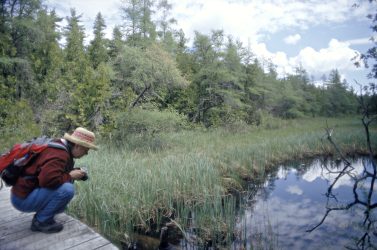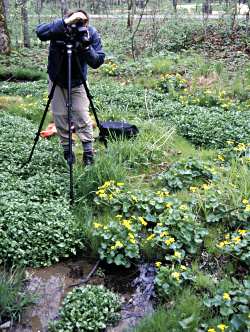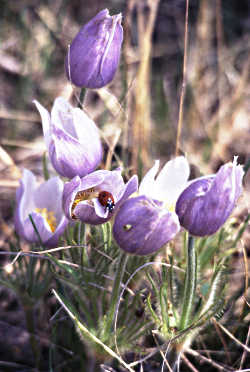Tiptoeing through the toothwort
With their cameras, nature-lovers try to capture the fleeting joys of spring.

© Beth Gauper
Nothing is more exhilarating than the first days of spring, when the air practically vibrates with the pent-up vigor of growing things.
Warm sunlight filters down through budding forests, and the rich smell of humus wafts up from their floors. Then, amid the decaying leaves and grasses, we find the first spring ephemerals.
They gladden our hearts, those brave little blooms. But they come, and then they go.
There's no way to preserve their beauty, except with a photograph, and even then, no one can capture the sheer luxuriance of thousands of Virginia bluebells or false rue anemone carpeting a forest floor. But people can try.
"We have lots of people come out with their cameras," says Kristine Hiller, naturalist at Jay Cooke State Park, where thick clumps of shiny yellow lady's-slipper attract photographers in early June. "Flowers don't move, so they're easy to photograph."
If needed, photos provide bragging rights: See, I did find that rare calypso orchid! I really did see a whole hillside covered with jeweled shooting stars!
And they're souvenirs, a memento of the time I stumbled on acres of trilliums while exploring one of Wisconsin's Rustic Roads. Or the stormy day at Blue Mounds State Park when I found the filmy pink strands of prairie smoke waving in the breeze.
Choosing the right subject
Of course, I'd already seen the definitive photograph of prairie smoke by Luverne native Jim Brandenburg, maybe even that exact same plant.
But it's just like the Eiffel Tower — you've seen a million pictures of it, but you still want one of your own.
And even though wildflowers don't move — except the ones on the prairie, which need to be photographed early in the day, before the wind kicks up — it still can be tricky to photograph them.
"People say, 'This didn't look anything like what I saw when I was there,' " says Edina photographer Mark Lissick, who has taught an online Photographing Flowers course.
"They take my class to find out how to capture images the way they see them. One of the first things I teach is how to find a good photo subject."
A whole field of false rue anemone, he says, is not necessarily a good subject. But a single anemone, nodding against the dewy leaf of a wild leek, would be.
"I like the teeniest ones you get out there," he says. "The design, the delicacy of construction — in the case of the bloodroot, the anemone, the Dutchman's breeches, their shape makes them very photogenic."
Copious quantities still are good, Lissick says, because he often scans hundreds of flowers before finding the perfect subject: "If population density is up, it makes life a little easier," he says.
When to look for wildflowers

© Beth Gauper
And even when you know where to find lots of flowers, timing can trip you up.
One April, I found thousands of pasque flowers blooming on the River Terrace Prairie scientific natural area near Cannon Falls. They should've been barely out, but thanks to unseasonably hot weather, they were already slightly past peak.
Then in May, cooler temperatures turned much of the region into a florist's refrigerator, keeping spring ephemerals blooming for three weeks, right up to the arrival of yellow and showy lady's slippers in late May.
It's hard to estimate arrival times, but in a year with average temperatures and moisture, look for spring ephemerals in the woods of central and south Minnesota and Wisconsin in late April or early May.
You'll see trout lilies, spring beauties, hepatica, bloodroot, false rue anemone, bellwort, Dutchman's breeches, toothwort, marsh marigolds, wild ginger and Virginia bluebells.
You'll see completely different plants on the goat prairies of southeast Minnesota, along the sandy Wisconsin River and in state parks with prairie, such as Wisconsin's Nelson Dewey and Minnesota's Great River Bluffs along the Mississippi and Blue Mounds and Buffalo River in western Minnesota.
In mid-May, look for pussytoes, hoary puccoon, Indian paintbrush, prairie smoke, blue-eyed grass, wood betony and jeweled and white shooting star.
In the middle of May, look for columbine, large-flowered trillium, harebells, blue wood phlox, spiderwort, May apple and wild geranium in the southerly forests, along with lady's-slipper in wetter locations.
In southwest Wisconsin, blue, purple and white dame's rocket, though not a wildflower, still provides scenery in ditches and on the edges of forests.
In northern forests and along the shores of Lake Superior and Lake Michigan, everything arrives a little later. In early and mid-June, look for lady's slipper, bluebead lily, coral root, Labrador tea, hawkweed, bunchberry and wild rose.
The pink, blue and purple blooms of lupine, a garden escapee, will fill roadside ditches.
There's no guarantee you'll find them when you look, of course. But that's what makes a treasure hunt fun.
Trip Tips: Getting to know spring wildflowers
Guided walks: In Minneapolis' Wirth Park, Eloise Butler Wildflower Garden in Minneapolis holds many wildflower walks in spring.

© Beth Gauper
Many Minnesota state parks also hold wildflower walks, including Whitewater in bluff country, William O'Brien on the St. Croix, Sibley State Park near Willmar, Jay Cooke near Duluth and Itasca in the north.
From late May through early July, Lake Bemidji State Park holds Bog Watcher Sundays, with a naturalist roving a quarter-mile boardwalk to help visitors locate uncommon flowers and insect-eating plants.
For details, check the Minnesota state parks events calendar.
Festivals: Over Memorial Day weekend, Ridges Sanctuary in Door County holds a Festival of Nature. For more, see Spring in Door County.
Where to find wildflowers: In addition to state parks, state natural areas are a good place to look for wildflowers, especially rare ones.
For more, see Spring in full glory.
The Mississippi River Valley in southeast Minnesota is a trove of flowers. For more, see Chasing spring wildflowers.
Look for wildflowers that thrive in the boreal forest on Minnesota's North Shore of Lake Superior. For more, see Wildflowers of the North Shore.
For prairie flowers, see 10 great places to find late-summer wildflowers.